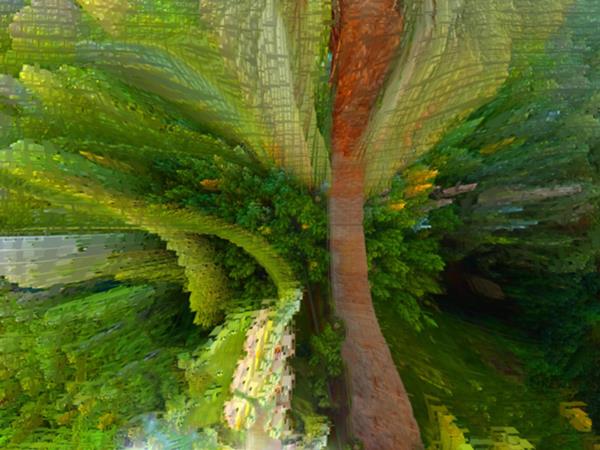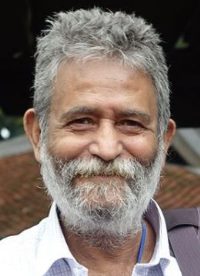Silence (22) - Tĩnh lặng (22). Mai Văn Phấn. Explicated by Dr. Ramesh Chandra Mukhopadhyaya - chú giải. Traduction française Dominique de Miscault – Dịch sang tiếng Pháp. Takya Đỗ dịch sang tiếng Việt
Silence (22) by Mai Văn Phấn
Explicated by Dr. Ramesh Chandra Mukhopadhyaya
Translated into French by Dominique de Miscault
Translated into Vietnamese by Takya Đỗ

Photo: Dominique de Miscault
Silence
22.
Sounds of wind chimes
Fall in the night as
sparkling seeds
I hardly realize
Tree trunks have just
grown
The garden has shrunk into
an arm’s embrace
Another lullaby of chimes
I sit up
Drop a coop around me to
stop the wind
And a myriad of sounds
The chimes are strung
On top of the
sky.
(Translated from Vietnamese by Nhat-Lang Le & Susan Blanshard)
Explication
The poem opens with the sounds of the
wind chimes. The wind is one of the fundamental elements of the existence. It
blows through the existence. Every living thing be it a man or an animal or a
tree breathes wind that is ever on the move. This is not all. Apparently our
body seems to be solid partially at least. But on the molecular level it is
largely made of water and on the atomic level it is 99 percent space. And since
nothing in the existence is solid the Chi or the life force flows through
everything. And no wonder the poet can hear the sounds of wind chime echoing
throughout the existence. When wind chimes are placed as tools for
decoration in a house its function is to remind us of the overmind rhythm that
is at the heart and crown of the existence. It is undoubtedly the positive Chi.
The electro magnetic field created by modern technology such as microwaves or
wi fi signals stand in the way of natural flow of this life force and creates
the night about us. Our ignorance has created the night about us. The wind-
chimes however fall in the night as sparkling seeds of
consciousness. Through the soundscape once we are aware of the motion and
spirit impelling the existence, the sparkling seeds fall on our ignorance that
posits the phenomenal world to be true.
Presently tree trunks grow and the garden
shrinks into an arm’s embrace. This is dramatic. As soon as the sparkling
enlightenment is scattered on the ground of darkness they grow into trunks of
trees. At once the world with all its weal and woe and width turns into a
garden as it were before the visionary poet. And the illimitable rock garden of
existence becomes as small as one that could be within the grasp of the embrace
of the poet’s arms. Or may be the pure land of Amida shows up before the
poet and shrinks into the poet’s arm’s embrace. In other words the poet in the
meantime has expanded enormously to have the world in arm’s embrace. The
poet is in the world and yet he is bigger than the world holding the world in
his arm’s embrace.
There is another lullaby of chimes.
Earlier the chimes littered sparkling seeds of consciousness in the poet’s
self. And the poet saw the vision of the world as a small garden within his
arm’s embrace. But now another spell of chimes drop a coop around the poet so
that he cannot hear or feel the wind anymore. His breath is suspended. The poet
sits up.
The chimes are strung
On top of the sky
In
other words when the poet is shielded from the wind chimes, the chimes are
internalized by the poet in the coop of his physical body. And he can hear it
in the sky of his being. He can hear it ringing in the heights of his crown or
cranium. The poet’s body becomes the microcosm of the existence in the skies of
which the chimes continue evermore expelling evil and conjuring bliss to
protect the poets and seers.
Explication par Dr. Ramesh Chandra Mukhopadhyaya
Traduction française Dominique de Miscault

Photo: Dominique de Miscault
Silence
22.
Dans la nuit le vent carillonne
les graines éclatent
Je réalise à peine
des arbres surgissent
le jardin est retenu par l'étreinte de mon bras
Carillons berceuses
je m'assois
En cage à l’abri du vent
une myriade de sons
Carillons enfilés
au sommet du ciel.
Explication du Dr Ramesh Chandra Mukhopadhyaya
Le poème introduit des carillons de
vent. Le vent est l'un des éléments fondamentaux de notre existence. Son
souffle traverse nos vies. Tout être humain, animal ou arbre respire le vent qui
passe. Ce n'est pas tout : En apparence, notre corps semble être solide
mais au niveau moléculaire, il est essentiellement constitué d'eau et, au
niveau atomique, il est fait de 99% de vide. Dans nos vies, rien n'est
stable ; le Chi[1] ou la force
de vie irrigue tout. Il n'est pas étonnant que le poète puisse entendre les
carillons du vent résonner tout au long de son existence. Lorsque qu’un
carillon est placé dans une maison, sa fonction est de nous rappeler le rythme
de la vie sur la mort : C'est sans doute le Chi positif. Le champ
électromagnétique créé par la technologie moderne, comme les micro-ondes ou les
signaux Wi-Fi, entravent la circulation naturelle de cette force de vie et
fabriquent nos nuits. Notre ignorance crée notre obscurité. Les carillons de
vent tombent dans la nuit comme des graines pétillantes de conscience. Dans ce
paysage sonore conscient du mouvement et de l'esprit qui engendre l'existence,
les graines pétillantes tombent sur notre ignorance ce qui suppose que notre
monde phénoménal existe bel et bien.
À ce moment précis, les troncs d'arbres
grandissent et le jardin se rétrécit dans l'étreinte d'un bras - Drame absolu -
Dès que les éclats étincelants sont dispersés sur le sol obscure, ils se
transforment en troncs d'arbres. Le monde avec son bien-être et sa mort se
transforme en un jardin comme le pressant le poète visionnaire. Le jardin
illimité de l'existence devient si petit qu’il est embrassé par une simple
étreinte. Peut-être même que la terre pure d'Amida[2] rétrécirait
sous l'étreinte du poète. Le poète s’est démultiplié pour étreindre le monde.
Le poète est dans le monde mais il est plus grand que le monde puis qu’il
retient le monde de son bras.
Carillons de berceuses, carillons de
graines scintillantes de conscience. Mai Van Phan crée un monde réduit, un
jardin étreint par son bras. Mais un autre type de carillons dépose une cage
autour du poète afin qu'il ne puisse plus entendre ou sentir le vent. Son
souffle est suspendu. Le poète est assis.
Les carillons sont tendus au-dessus
dans les cieux.
Lorsque le poète est protégé par les
carillons du vent, les carillons sont intériorisés dans son corps. Il peut tout
écouter dans le ciel de son être. Il peut entendre les carillons sur sa
couronne ou le sommet de sa tête. Le corps du poète est microcosme dans les
cieux où les carillons continuent à expulser le mal et à convoquer le bonheur
pour protéger les poètes et les voyants.
Le chi : il s'agit d'une énergie vibrant plus rapidement et
elle est beaucoup plus difficile à sentir. Elle est souvent reliée à
l'émotionnel. C'est l'énergie qui coule dans les méridiens d'acupuncture et qui
circule également partout autour de nous. On peut la diviser en énergies yin et
yang. Sa manifestation première est la sensation de courants
« magnétiques » à l'intérieur du corps ou à la surface de la peau.
Elle peut rendre le geste plus relaxé, plus lourd ou plus léger. Notons que le
chi ne peut circuler harmonieusement dans un muscle contracté car elle y stagne
(ce qui peut provoquer, à long terme, des blocages physiques et des maladies).
Le chi des méridiens d'acupuncture est aujourd'hui reconnu par la science et il
est détectable et mesurable par des instruments.
Amida est le nom japonais du bouddha Amitabha, popularisé par le
bouddhisme de la Terre pure. La Terre pure désigne l'univers
occidental Béatitude du bouddha « Lumière-Infinie »), aussi
nommé Amitāyus « Vie-Infinie »). C'est aussi une appellation
simplifiée de l'école de la Terre pure (jìngtǔzōng 淨土宗),
improprement dit Amidisme, une section très importante du bouddhisme mahayana.

Tác Phẩm "Cuộc sống lay động" của Dominique de Miscault
Tĩnh lặng (22) của Mai Văn Phấn
Ramesh Chandra Mukhopadhyaya chú giải
Takya Đỗ dịch sang tiếng Việt
22.
Tiếng chuông gió
Rơi trong đêm những hạt sáng
Tôi thoáng biết
Những thân cây vừa nở
Khu vườn hẹp lại trong vòng tay
Hồi chuông nữa vang lên
Tôi ngồi dậy
Rắc quanh tôi chiếc lồng ngăn gió
Ngăn muôn tiếng động
Chuông treo
Trên đỉnh trời.
Chú giải:
Bài thơ mở ra với
tiếng chuông gió. Gió là một trong những thành tố cơ bản của hiện tồn. Nó
thổi qua hiện tồn. Mọi sinh vật bất kể là người hay động vật hoặc cây cối đều hít
thở làn gió không ngừng chuyển động. Đó chưa phải là tất cả. Nhìn bề ngoài
dường như ít nhất là một phần cơ thể chúng ta ở thể rắn. Nhưng ở cấp độ phân tử
thì cơ thể đó hầu hết được tạo thành từ nước, và ở cấp độ nguyên tử thì 99% là chân
không. Và vì
không có thứ gì trong hiện tồn lại rắn đặc, nên Chân khí [Chi] hay sinh lực chảy xuyên qua tất cả mọi thứ. Và chẳng có gì
đáng ngạc nhiên khi nhà thơ có thể nghe thấy tiếng chuông gió vọng thấu suốt
hiện tồn. Khi chuông gió được treo như đồ trang trí ở một ngôi nhà, việc của nó
là nhắc cho ta nhớ nhịp điệu siêu cảm thức ở chính
tâm và trên đỉnh hiện tồn. Đó hiển nhiên là Chân khí tích cực. Trường điện từ
được tạo ra bởi công nghệ hiện đại như lò vi sóng hay tín hiệu wifi cản trở
dòng chảy tự nhiên của luồng sinh khí này và tạo thành bóng đêm vây phủ quanh
ta. Sự vô minh của ta cũng đã tạo thành bóng đêm vây phủ quanh ta. Song tiếng
chuông gió rơi vào bóng đêm ấy như những hạt nhận thức sáng lấp lánh. Thông qua
cái không gian âm thanh đó ta nhận thức được sự chuyển động và tinh thần đang
thúc đẩy hiện tồn, những hạt sáng rơi rắc lên vô minh của ta đã biến thế giới
hiện tượng thành thế giới thực.
Những thân cây tức
thì lớn dậy và khu vườn thu gọn vào vòng tay. Hình ảnh này thật ấn tượng. Ngay
khi tuệ giác lấp lánh sáng nó rơi rắc những hạt sáng lên mặt đất tăm tối và
những hạt này nở thành những thân cây. Có thể nói thế giới với tất cả hạnh phúc,
khổ đau và sự mênh mông của nó lập tức biến thành một khu vườn trước nhà thơ
tiên kiến. Và cái khu vườn đá mênh mông của hiện tồn bỗng thành bé nhỏ như khu
vườn nằm trọn trong vòng tay của nhà thơ. Và cũng có thể là cõi tịnh độ của Đức phật A-di-đà hiện
ra trước mắt nhà thơ và thu gọn vào vòng tay ông. Nói cách khác, nhà thơ đồng
thời mở rộng vòng tay ra vô cùng tận để ôm cả thế giới vào. Nhà thơ ở bên trong thế giới nhưng ông cũng
lớn hơn thế giới đó để giữ nó trong vòng tay mình.
Có một bài hát ru
khác của tiếng chuông ở đó. Bên trên ta đã thấy chiếc chuông rắc những hạt nhận
thức sáng lấp lánh trong bản ngã của nhà thơ. Và nhà thơ nhìn thấy viễn ảnh về
thế giới như một khu vườn nhỏ trong vòng tay mình. Nhưng lúc này một hồi chuông
khác buông một chiếc lồng chụp xuống nhà thơ thế nên ông chẳng thể nghe hoặc
cảm thấy tiếng chuông nữa. Hơi thở ông ngừng lặng. Nhà thơ ngồi lên.
Chuông treo
Trên đỉnh trời.
Nói cách khác, khi nhà thơ bị che chắn khỏi tiếng
chuông gió, tiếng chuông đã được nhà thơ nội tại hóa bên trong chiếc lồng tượng
trưng cho thân xác phàm trần của ông. Và ông có thể nghe được tiếng chuông trên
cõi trời tượng trưng cho bản thể mình. Ông có thể nghe thấy nó rung ngân trên
đỉnh đầu mình. Thân thể nhà thơ trở thành một thế giới thu nhỏ của hiện tồn
trên những cõi trời nơi tiếng chuông vĩnh viễn tiếp tục xua đuổi tà ma và gọi niết bàn hiện lên để bảo vệ các nhà thơ và các nhà tiên tri.
Chỉ cõi Tây phương Cực lạc, nơi Phật A-di-đà (Amida) ngự trị. (ND)
Tĩnh lặng - Silence (1)
Tĩnh lặng - Silence (2)
Tĩnh lặng - Silence (3)
Tĩnh lặng - Silence (4)
Tĩnh lặng - Silence (5)
Tĩnh lặng - Silence (6)
Tĩnh lặng - Silence (7)
Tĩnh lặng - Silence (8)
Tĩnh lặng - Silence (9)
Tĩnh lặng - Silence (10)
Tĩnh lặng - Silence (11)
Tĩnh lặng - Silence (12)
Tĩnh lặng - Silence (13)
Tĩnh lặng - Silence (14)
Tĩnh lặng - Silence (15)
Tĩnh lặng - Silence (16)
Tĩnh lặng - Silence (17)
Tĩnh lặng - Silence (18)
Tĩnh lặng - Silence (19)
Tĩnh lặng - Silence (20)
Tĩnh lặng - Silence (21)

Ts. Ramesh Chandra Mukhopadhyaya
Dr. Ramesh Chandra Mukhopadhyaya
Address: 6/ 1 Amrita Lal Nath lane P.0. Belur Math Dist Howrah West Bengal India Pin code711202. Date of Birth 11 02 1947. Education M.A [ triple] M Phil Ph D Sutrapitaka tirtha plus degree in homeopathy. He remains a retired teacher of B.B. College, Asansol, India. He has published books in different academic fields including religion, sociology, literature, economics, politics and so on. Most of his books have been written in vernacular i.e. Bengali. Was awarded gold medal by the University of Calcutta for studies in modern Bengali drama.
TS. Ramesh Chandra Mukhopadhyaya
Địa chỉ: 6/ 1 đường Amrita Lal Nath hòm thư Belur Math Dist Howrah Tây Bengal Ấn Độ mã số 711202. Ngày sinh: 11 02 1947. Thạc sĩ văn chương, thạc sĩ triết học, tiến sĩ triết học [bộ ba] cùng với Bằng y học về phép chữa vi lượng đồng cân. Ông còn là một giảng viên đã nghỉ hưu của Trường đại học B.B, Asansol, Ấn Độ. Ông đã có những cuốn sách được xuất bản về nhiều lĩnh vực học thuật bao gồm tôn giáo, xã hội học, văn học, kinh tế, chính trị v.v. Hầu hết sách của ông đã được viết bằng tiếng bản địa là tiếng Bengal. Ông đã được tặng thưởng huy chương vàng của Trường đại học Calcutta về các nghiên cứu nghệ thuật sân khấu Bengal hiện đại.

Nhà thơ - Nghệ sỹ Dominique de Miscault
Poétesse - Artiste Dominique de Miscault
Artiste Plasticienne. Actualités. De plages en pages qui se tournent. C’était hier, de 1967 à 1980, mais aussi avant hier. puis de 1981 à 1992. Et encore de 1992 à 2012 bien au delà des frontières. Aujourd’hui, la plage est blanche sous le bleu du soleil. Ecrire en images, cacher les mots porteurs de souffrance ; on ne raconte pas les pas d’une vie qui commence en 1947. C’est en 1969 que j’ai été invitée à exposer pour la première fois. Depuis j’ai eu l’occasion de « vagabonder » seule ou en groupe en France et dans le monde sûrement près de 300 fois. Les matériaux légers sont mes supports, ceux du voyage et de l’oubli.
www.dominiquedemiscault.fr
www.dominiquedemiscault.com
www.aleksander-lobanov.com
Nhà thơ - Nghệ sỹ Dominique de Miscault
Nghệ sĩ nghệ thuật thị giác đương đại. Từ bãi biển đến trang giấy. Là ngày hôm qua, từ 1967 đến 1980, và trước đó, rồi từ 1981 đến 1992. Và nữa từ 1992 đến 2012 trên tất cả các biên giới. Ngày hôm nay là bãi biển trắng dưới bầu trời xanh. Viết bằng hình ảnh, giấu từ ngữ mang nỗi đau, người ta không kể lại những bước đi trong cuộc đời tính từ năm 1947. Vào năm 1969, lần đầu tiên tôi được mời triển lãm tác phẩm. Kể từ đó, tôi có cơ hội một mình "lang bạt" hoặc theo nhóm ở nước Pháp và khắp nơi trên thế giới, chắc chắn gần 300 lần. Những chất liệu nhẹ là nguồn hỗ trợ tôi, những chất liệu của hành trình và quên lãng.
www.dominiquedemiscault.fr
www.dominiquedemiscault.com
www.aleksander-lobanov.com

Photo: Dominique de Miscault